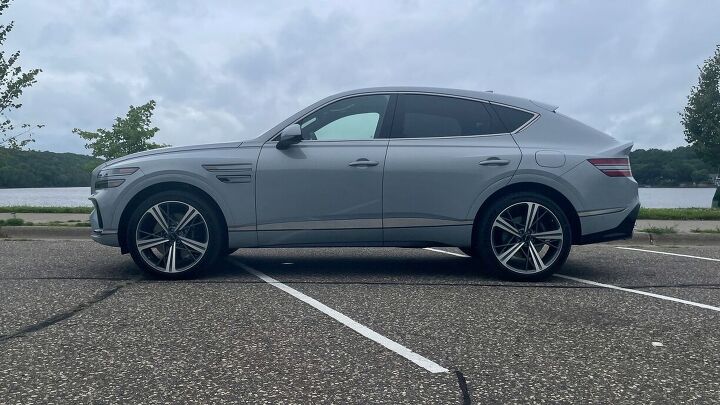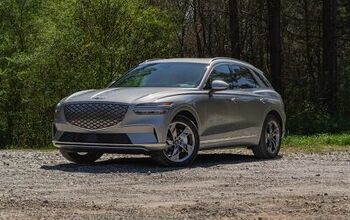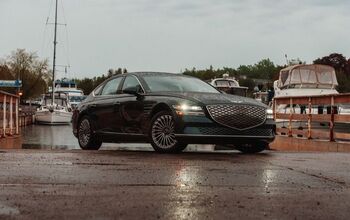Genesis GV80 Coupe First Drive Review

In many respects, the 2025 Genesis GV80 Coupe is a sea-change vehicle that marks the beginning of the Korean automaker’s shift towards performance.
While the GV80 Coupe isn’t being positioned as a gilt-edged performance vehicle – that’s what the company’s upcoming Magma sub-brand is for – it is certainly sportier than its GV80 SUV, thanks in large measure to the availability of a twin-turbo V6 equipped with an electric supercharger. The GV80 Coupe is the first Genesis so equipped.
AutoGuide recently traveled to Minneapolis to get some seat time behind the wheel of the GV80 Coupe as part of a media preview.
Quick Take
While Genesis reps may be somewhat hesitant to use the word performance to describe the 2025 GV80 Coupe, there is no doubt this vehicle is a big step in that direction for the Korean luxury automaker. It’s the first Genesis vehicle to be equipped with a 48-volt electric supercharger, which pushes output to 409 horsepower and 405 lb-ft. of torque and puts it squarely in German SUV Coupe territory.
Combined with unique design cues, and packaging options that separate it from its GV80 SUV sibling, the GV80 Coupe marks a sportier turn for Genesis, and hints at what the marque might have in store for Magma, its forthcoming performance sub-brand.
Exterior Style
Clearly, the GV80 Coupe shares a strong family resemblance with its newly facelifted GV80 SUV stablemate, but Genesis designers have deviated from the SUV on several fronts to give the Coupe a unique, and sportier, appearance.
Starting at the front, the Coupe receives a unique Crest Grille that sports a G-Matrix, dual-layered design not found on the SUV. The Coupe also sports a larger front bumper, bigger air curtain, and larger lower air intakes that have a sporty 3D look.
Viewed from the side, the most noticeable difference is the roofline, which has a much more dramatic downward slope at the rear than its SUV counterpart. The Coupe also comes with flush “hidden” roof rails, and a Dark Chrome garnish application above lower rocker panels on the E-Supercharger trim. As for wheels, the Coupe features unique 20 and 22-inch wheels, along with black brake calipers (E-SC trim only).
Finally, at the rear, the Coupe sports a unique bumper design and rear combination taillights, dual and quad (E-SC trim) exhaust finishers. The Coupe also has a unique roof spoiler, an auxiliary brake light integrated into the deck lid, and slightly repositioned Genesis badge compared to the SUV.
As for colors, there are nine for the U.S., including Bering Blue (shown) and Mauna Red which are exclusive to the Coupe. For Canada, there are 11, which include two matte finishes (Storr Green and Matterhorn White) not offered in the U.S.
Powertrain and Fuel Economy
Like its GV80 SUV sibling, the GV80 Coupe comes outfitted with the 3.5-liter twin-turbo V6, but it serves as the base engine in the latter, not the top motor as with the SUV. Output remains the same in the Coupe, as it is with the SUV: 375 horsepower and 391 lb-ft. of torque.
What separates the Coupe from the SUV is the optional engine for the U.S. market, (standard for Canada), which is the 3.5-liter twin-turbo outfitted with a 48-volt electric supercharger. The e-supercharger makes a big difference in output, as it pushes a blistering 409 horsepower and 405 lb-ft. of torque through the twin-turbo V6. Both engines are paired with an eight-speed automatic transmission and standard all-wheel drive.
In terms of fuel economy, the base twin-turbo V6 is rated at 16 mpg city and 22 mpg highway, while the V6 equipped with the e-supercharger delivers 18 mpg (13.1 L/100 km) city, and 22 mpg (10.7 L/100 km) highway.
Handling and Driveability
The GV80 Coupe has the look of a performance-oriented vehicle, and it drives like one. The E-SC unit I drove on roads through Minnesota and Wisconsin carried a sporty vibe that permeated throughout its driving character.
Much of this has to do with its E-SC status, but Genesis has done more than simply bolt a supercharger onto the 3.5-liter twin-turbo V6 and call it a day. It has also outfitted the E-SC with features not found on the base Coupe: Sport+ drive mode and launch control.
We didn’t test the latter, but the former was used frequently during the drive, and it really enhances the ES-C Coupe’s driving character. As it does with other cars, Sport+ provides a sportier transmission shift pattern, holds gears before upshifting, bumps engine idle (750 to 1,000 rpm), delivers weightier steering effort, and firms up suspension tuning.
Taken together with a powerplant that delivers 409 horsepower and 405 lb-ft. of torque, these additions deliver a very dynamic driving experience. The E-SC Coupe is fast, responsive, and has loads of power in reserve, which makes it great for highway merging, slicing through slower traffic, and cornering.
Its quick steering reflexes, powerful brakes (which are aided by an electronic brake booster), electronically controlled suspension, and standard electronic LSD keep the E-SC Coupe firmly planted to the tarmac.
Ride Quality and Comfort
On most highways, city streets, and country roads we sampled in the Minneapolis region, the GV80 Coupe delivered a quiet, well-composed, and comfortable ride. Given the E-SC models we drove come with a stiffer suspension setup and 22-inch wheels, we thought the ride might be a bit jittery over rougher pavement. It was, but it wasn’t noticeably worse than that of similar vehicles.
Road and wind noise isn’t too intrusive either, and the GV80 Coupe is equipped with acoustic glass and active noise cancellation. As with many sporty vehicles, engine revs can be pumped into the cabin for those seeking a more visceral driving experience. Genesis calls it Sport Active Sound Design.
We left it on at the start of the drive but turned it off before the first rest stop. Even with it turned off, some muffled exhaust sound could be heard in the cabin under acceleration and off-throttle. We thought it was just the right amount, as it enhances the car’s sporty character.
On the utility front, the GV80 Coupe has motorized rear seatbacks, and plenty of head, knee and legroom for both front and rear seat passengers. Its sleek roofline doesn’t penalize occupants either, as passenger volume is the same as that of the SUV. Cargo space is reduced, however, by 10.6 cubic feet (300 liters) with the second-row seats folded down, and by 6.5 cu-ft. (184 liters) when they’re upright. Maximum towing is rated at 6,000 pounds (2,722 kg.), same as the SUV.
Interior Style and Quality
The GV80 Coupe’s cabin comes well stocked and is a mix of features shared with the GV80 SUV, and those that are unique. On the shared side, there’s a beautiful 27-inch OLED display that serves as digital instrument cluster and multimedia touchscreen. Unlike other big displays, this one isn’t segmented into two panels, which allows the map to bleed across the entire screen.
Like many automotive displays, it can be configured in several ways, and changes with drive mode setting. Also shared with the GV80 SUV is the main center console area, where the climate control touch panel, gear selector knobs and cup holders are identical.
Where things begin to shift into bespoke for the Coupe, are available colors and finer details. For example, the Coupe comes with a standard D-cut steering wheel. The E-SC grade also comes with a lot of standard carbon fiber accents that have been placed in the dash and door panels.
Then there are colors. Obsidian Black is the only color both SUV and Coupe share. The three others available for the Coupe – Smoky Green, Obsidian Black / Sevilla Red, and Ultramarine Blue – are not offered for the SUV.
I haven’t mentioned standard content, but both Coupe models come with loads of it. Genesis said that, from a content perspective, both models sit above the top-level SUV model, the 3.5T Prestige. For the U.S., this means that both the 3.5T AWD and E-SC trims have standard features such as Nappa leather seating, Bang & Olufsen Premium Audio, panoramic roof, 3-zone climate control, active noise control, heated and ventilated front and rear seats, head-up display, a full suite of advanced safety kit and a lot more.
Unique to the E-SC grade are standard 22-inch sport alloy wheels (20-inch on 3.5T AWD), quad muffler tips, dark chrome exterior trim accents, metal pedals, and black monobloc brake calipers. All of this is standard for Canada, as the E-SC model is the only grade available.
Generally, the GV80 Coupe delivers on the feeling of sporty luxury, and fine attention to detail. The sheer amount of tech is impressive, but the car also nails the execution of finer details, which really matter to buyers in premium segments.
Value Dollars and Sense
The 2025 Genesis GV80 Coupe 3.5T AWD carries a starting price of $81,300, while the E-SC model checks in at $87,100 (all prices include destination). Of note, there are few options available for the Coupe, apart from colors, some of which carry an extra charge. Some metallic finishes are $650 extra, while matte options are $1,500.
In Canada, the GV80 Coupe is available with E-SC only, and it carries a price of $104,000, which includes destination. Like the U.S., some exterior colors carry an extra charge which ranges from $500 for metallic, and up to $1,700 for matte.
In terms of competition, the GV80 Coupe undercuts its German competitors in the U.S., such as the BMW X6 M60i, and Porsche Cayenne Coupe. The base BMW X6 is slightly less than the GV80 Coupe in Canada, but the Mercedes-AMG GLE 53 has a higher MSRP, while the Porsche Cayenne Coupe is roughly equivalent.
Final Thoughts
As a first Genesis entrant into the sporty Coupe-SUV segment, the 2025 GV80 Coupe hits the mark. It has enough features that overlap with its SUV sibling to make it appealing for a buyer who wants the SUV’s utility and luxury, but would also appreciate more power, a sportier character, and some unique features.
We should know more about Genesis’ plans for its Magma high-performance sub-brand in the coming months but, as I said to one of their reps in Minnesota, the GV80 Coupe seems like a logical candidate for full Magma. Out of the box, I’d say it’s at least halfway there.
Become an AutoGuide insider. Get the latest from the automotive world first by subscribing to our newsletter here.
Pros | Cons |
|---|---|
E-supercharger | Fussy steering wheel buttons |
Sleek coupe styling | Lack of performance pedigree |
Stylish, high-tech cabin | Pricey |
Engine / Motor | 3.5L twin-turbo V6 |
Output | 375 hp / 391 lb-ft (409 / 405 w/ E-Supercharger) |
Drivetrain | AWD |
Transmission | 8AT |
Fuel Economy MPG | 16 city, 22 highway (18 / 22) |
Fuel Economy L/100 km | 13.1 city, 10.7 highway (E-Supercharger) |
Starting Price USA | $81,300 |
Starting Price Canada | $104,000 |
As Tested Price USA | $87,100 |
As Tested Price Canada | $104,000 |

With more than 20 years of industry experience, which includes automotive retail, motorsports PR, and writing and editing for various automotive publications, Lee is an AutoGuide freelancer, and car guy to the core. For nearly a decade and a half, he has married his two consuming passions together – journalism and the automotive industry. Whether it’s providing coverage on debuts from an auto show floor, writing road test reviews, or previewing a new model coming soon, Lee is eager to share his passion for the automotive industry with his readers. He is a long-standing member of the Automobile Journalists Association of Canada (AJAC) and won a feature writing award in 2018.
More by Lee Bailie







































Comments
Join the conversation
People are NOT buying cars because of their over MSRP prices & Bidenomics. $80,000 for a Korean car. no thanks. I stick with LEXUS although their quality like most cars today has gone DOWN. Toyota's UGLY FRONT GRILLS turns older people OFF. I'll keep my 2006 Avalon with 63, 000 miles. I wish today's Toyota's were built as good & had actual pretty grills
Why no rear wiper?